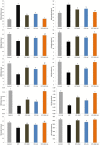Effects of Nigella sativa oil and ascorbic acid against oxytetracycline-induced hepato-renal toxicity in rabbits
- PMID: 25945233
- PMCID: PMC4414986
Effects of Nigella sativa oil and ascorbic acid against oxytetracycline-induced hepato-renal toxicity in rabbits
Abstract
Objectives: Oxytetracycline (OTC) is a broad spectrum antibiotic widely used for treatment of a wide range of infections. However, its improper human and animal use leads to toxic effects, including hepatonephrotoxicity. Our objective was to evaluate protective effects of Nigella sativa oil (NSO) and/or ascorbic acid (AA), against OTC-induced hepatonephrotoxicity in rabbits.
Materials and methods: Forty male white New Zealand rabbits were divided into 5 groups of eight each. The 1(st) group (control) was given saline. The 2(nd) group was given OTC (200 mg/kg, orally). The 3(rd) and 4(th) groups were orally administered NSO and AA (2 ml/kg and 200 mg/kg respectively) 1 hr before OTC administration at the same dose regimen used for the 2(nd) group. Both NSO and AA were given in combination for the 5(th) group along with OTC administration. Serum biochemical parameters related to liver and kidney injury were evaluated, and lipid peroxidation as well as antioxidant markers in hepatic and renal tissues were examined.
Results: OTC-treated animals revealed significant alterations in serum biochemical hepato-renal injury markers, and showed a markedly increase in hepato-renal lipid peroxidation and inhibition in tissue antioxidant biomarkers. NSO and AA protect against OTC-induced serum and tissue biochemical alterations when each of them is used alone or in combination along with OTC treatment. Furthermore, both NSO and AA produced synergetic hepatoprotective and antioxidant properties.
Conclusion: The present study revealed the preventive role of NSO and/or AA against the toxic effects of OTC through their free radical-scavenging and potent antioxidant activities.
Keywords: Antioxidant; Ascorbic acid; Hepato-Renal; Nigella sativa; Oxytetracycline; Rabbit.
Conflict of interest statement
The authors declare that there are no conflicts of interest.
Figures

References
-
- Nelson ML, Levy SB. The history of the tetracyclines. Ann N Y Acad Sci. 2011;1241:17–32. - PubMed
-
- Polec RB, Yeh SD, Shils ME. Protective effect of ascorbic acid, isoascorbic acid and mannitol against tetracycline-induced nephrotoxicity. J Pharmacol Exp Ther. 1971;178:152–158. - PubMed
-
- Naseer F, Alam M. The protective effect of ascorbic acid on oxytetracycline induced nephrotoxicity and hepatotoxicity. J Pak Med Assoc. 1987;37:73–75. - PubMed
-
- Saraswat B, Visen PK, Patnaik GK, Dhawan BN. Protective effect of picroliv, active constituent of Picrorhiza kurrooa, against oxytetracycline induced hepatic damage. Indian J Exp Biol. 1997;35:1302–1305. - PubMed
LinkOut - more resources
Full Text Sources
Miscellaneous
